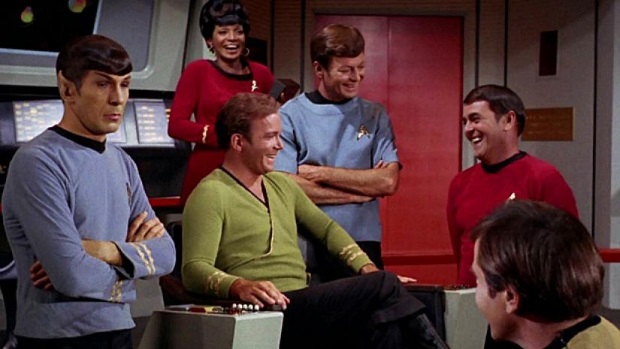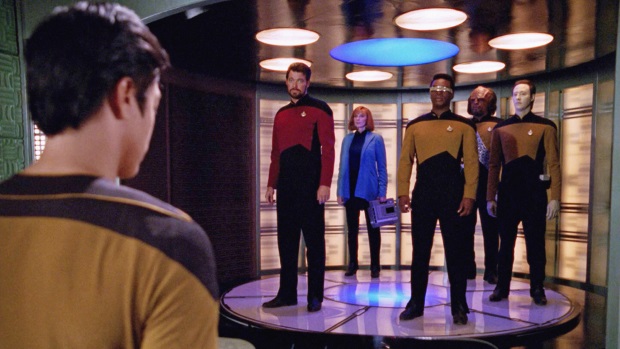Star Trek: Why We Can’t Wait to Go Back to the 24th Century
Captain Picard will return to our screens in a new Star Trek series, but is he all that’s needed to rekindle the Next Generation flame?
This article comes from Den of Geek UK.
Even with the success of the divisive Star Trek: Discovery ringing fresh in our ears, CBS’s bold declaration that it was not only renewing the show for a second season, but also investigating a staggering five additional entries in the Star Trek canon, couldn’t help but raise a few Spock-styled eyebrows. Wisely, the network decided to allay fears of franchise fatigue with a piece of news that seemed designed to elicit good will, especially from fans who remained sceptical of alternative takes on the Original Series era: Sir Patrick Stewart is set to return as Jean-Luc Picard.
The response to this news was, by and large, incredibly positive. Articles and videos began popping up online to discuss the new series, which was to be set twenty-five years after Star Trek: Nemesis and show us an older Picard whose life, we were promised, had taken some unexpected turns. This was a brilliant casting choice, the articles explained, for Picard is precisely the kind of role model we need in a time when emotive, insular reactions seem to be ruling in place of rational thought and inquisitive spirit.
While it’s undeniably exciting to think that Nemesis (a film which is rarely considered to be a top-tier entry even by those that do enjoy it) will not be the last we see of Picard, it’s too simplistic to say that his inclusion is all we’re looking for from content set in that era of Star Trek’s prime timeline. Our desire to see more stories from those years is, one can argue, because the place – all seventy thousand light years of it – is as important to us as the people.
Why is this, though? Surely Star Trek is the same universe, filled with Vulcans, photon torpedoes and subspace anomalies regardless of which ship and which continuity you’re watching? Well, not necessarily, and the reason stems back to the very heart of Star Trek’s original pitch. This meant that episodes needed to be entirely self-enclosed, with characters returning to the status quo at the end of each adventure so that networks could play them in any order, using a handful of Kirk’s escapades to neatly plug holes in their schedule whenever they needed to.
With The Original Series, it’s possible to dive into any episode (bar, possibly, the series’ lone two-parter) and quickly grasp not just the plot, but the dynamics between the three lead characters. McCoy is never shown to grow more tolerant of Spock’s stoicism, for instance – we assume that their friendship is growing stronger over time, because that’s what friendships often do, but there’s no real evidence of that within the show itself. Nobody is promoted or reassigned, the main characters are effectively immortal and past adventures are spoken of only in oblique terms even when villains like Harry Mudd do make a return appearance, many of which happened in the animated follow-up rather than the live-action show.

Even the aborted sequel Star Trek: Phase II would likely have continued to tell isolated, stand-alone adventures, but the Star Trek movies began to head down a very different path. Even when the films didn’t immediately follow on from one another, they began to embrace the show’s own continuity and build upon past events, allowing the characters to grow and change over time.
Likewise, 1987’s Star Trek: The Next Generation, which debuted while the original crew were still riding high at the box office, almost immediately went out of its way to push beyond the confines of syndicated TV. During its pilot episode, “Encounter At Farpoint,” we see the main cast encountering one another for the first time – along with a few reunions – and as they get acquainted, we come to know them too. Early on the story chooses to follow Riker, using him as our proxy while he tours this unfamiliar Enterprise and meets its austere new captain. It’s a measured and deliberate premiere that takes time to make its audience familiar not just with the full ensemble cast, but also with the ship they’ll be calling home. (By contrast, despite some contradictory takes in comics and an excellent novel by Vonda N. McIntyre, we still don’t know for sure how prime-universe Kirk, Spock, and McCoy first met.)
As the story goes, TNG’s original remit would have been to make a clean break within the series canon, never acknowledging The Original Series. James T. Kirk, it was felt, would have long ago been consigned to history as just another heroic Starfleet captain. In practice, this conceit is discarded barely half an hour into the pilot, when DeForest Kelley’s unnamed character appears to give the ship and its crew his blessing. Given that the very next episode would go on to be a sequel of sorts to classic story “The Naked Time,” the message was loud and clear: The Next Generation would unrepentantly build upon what had come before.
“Encounter At Farpoint” also introduced Q as its antagonist, who not only bookends the series but makes regular appearances throughout TNG and its spin-offs to the point that he’s arguably just as recognizable a Star Trek staple as Picard himself. Quite apart from his appearances on Deep Space Nine and Voyager, the sardonic super-being also hosts CD-ROM trivia quizzes, interactive Borg invasions, and is currently the Master of Ceremonies in the Star Trek Timelines mobile card game. Q set a fresh precedent for a number of returning villains across the years, ranging from Data’s evil twin to the manipulative Commander Tomalak, and the Alpha Quadrant felt all the more cohesive for it.
Technical consistency had always been taken seriously in The Original Series, with Gene Roddenberry’s extensive show bibles and a swathe of supplementary documentation ensuring that technology like the transporter was operated the same way from episode to episode. When it came to producing TNG, however, even greater care needed to be taken – this was the age of the VCR, and eagle-eyed fans were able to repeatedly pore over episodes to their heart’s content. If Counsellor Troi’s quarters were established as being on Deck Eight one week, that was where they needed to stay, or there’d be hell to pay at the next convention.

Little by little, Star Trek was laying the foundations for a larger universe. As an audience, we finally caught a look at Qo’Nos, Romulus, and Betazed. We got to experience life aboard Klingon and Ferengi vessels, visit Starfleet Academy and learned to spot the difference between starship classes. Characters took on new jobs, accepted promotions and got married, and while these changes were rarely so massive that they fundamentally changed the dynamic of the show, they still mattered, both to the characters themselves and to us.
It was, perhaps, the launch of Deep Space Nine and the exodus of several regular characters that helped cement Star Trek as something with a lore that mattered. While not particularly commonplace, crossovers of characters and themes did occur – rebel group The Maquis first appeared by name in Deep Space Nine, for example, but had had the seeds of their discontent sown in a TNG episode that aired a few weeks prior. Even if characters weren’t popping up in one another’s programs every week, it certainly felt like they could.
To anyone growing up who desperately wished they could spend time in Star Trek’s universe, this world-building was hugely important. Whether you were modelling the Enterprise in Doom, prepping your latest cosplay ensemble, or fleshing out a Klingon warrior for an online MUD, a group of Hollywood’s most talented creators were bringing you and fans like you into a complex and nuanced fantasy universe, expanding and enriching it in 45-minute increments every week.
Having created a rich tapestry of alien cultures and worlds, the writers soon began to unravel it in search of new stories to tell, shifting threads and recombining them in new patterns. The Maquis were destroyed at the hands of the Dominion even as the Klingon Empire severed ties with the Federation and launched an invasion of Cardassia. The Ferengi Alliance found itself with a Grand Nagus promoting equal rights and free commerce, while the Romulan Senate was completely annihilated.
These were huge, sweeping changes that created seismic shifts in the world of Star Trek and permanently changed the political landscape of the galaxy – and yet Voyager’s culmination and the end of the TNG movies meant that, suddenly, there was nowhere left to explore the ramifications. The questions raised in their wake, it seemed, would remain unanswered.

Well… mostly unanswered. While Rick Berman and Brannon Braga, overseeing the Star Trek franchise, set about creating Enterprise rather than follow the network’s expectation of another post-TNG series, there were plenty of creators still invested in the expanded universe that had grown up around the shows. Star Trek had always been very clear that books were to be considered non-canon, but without needing to worry about new movies or episodes that might contradict their ideas, tie-in novel writers began to collaborate, fleshing out a consistent cast of characters that would replace and replenish the crew of the USS Enterprise (as well as other in-universe ships like Titan and Voyager) no matter who was penning the story.
Unfortunately, the lack of any greater oversight meant that events in these novels never permeated through into other, conflicting sources like Star Trek Online. Picard, for example, either gave up command of the Enterprise-E after the events of Nemesis and became the Federation Ambassador to Vulcan for some reason, or he continued merrily onwards as a starship captain. Similarly, Data either remains dead, or he’s alive and well with his personality imprinted on B-4’s prototype body – it all depends on which part of the Expanded Universe you take to heart.
While it’s likely that the lore of any new Picard series will ride roughshod over both Star Trek Online and the novels, the chance to learn how everything ‘officially’ turned out for the galaxy is tantalising. New TNG-era books have all but dried up, after all, and Star Trek Online will doubtlessly find ways to adapt its content to agree with the new canon. With a bit of luck, we may even see a wealth of new spin-off material that cohesively fills in the gaps between Then and Now.
We are the next generation; the people who grew up with Picard and Sisko rather than Kirk and his crew. Nowadays, we’re the Netflix account holders and Blu-ray buyers; the key demographic that studios seek to keep entertained with the shows they produce. We can – and do – enjoy our journeys to Captain Kirk’s 23rd Century, but it’s not our home – not in the same way as the 24th had been. If Captain Picard, with all of his wisdom and compassion, is there to greet us upon our return to the Alpha Quadrant, so much the better – but don’t be fooled, CBS, he’s not the only reason we’re excited. Sometimes, it’s just nice to go home again.
